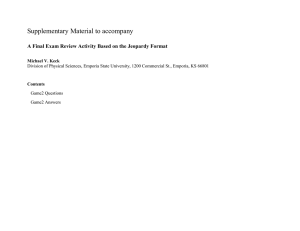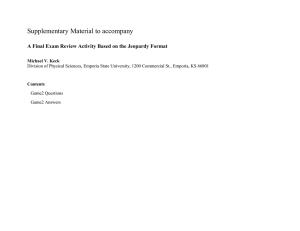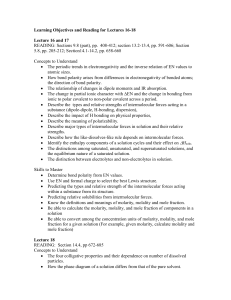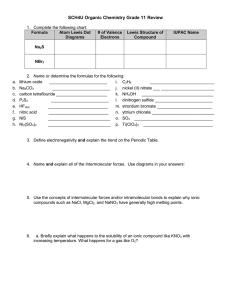Supplementary Material to accompany
advertisement
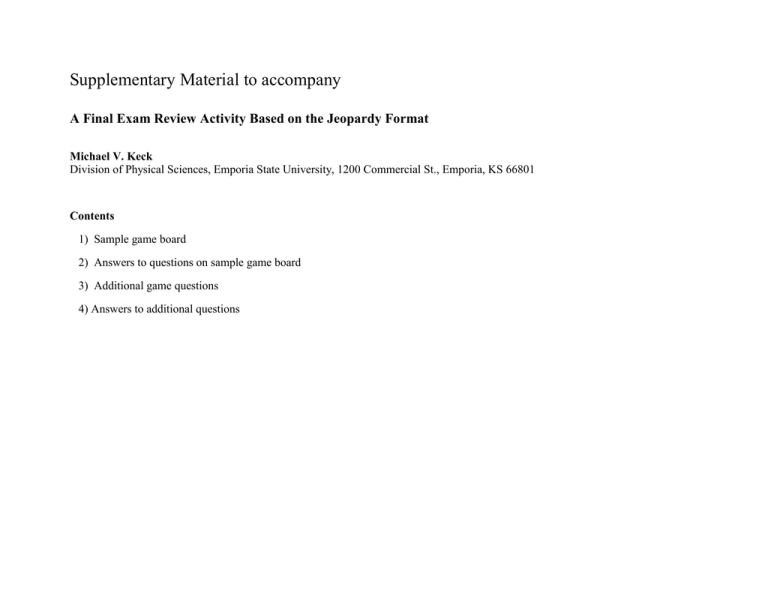
Supplementary Material to accompany A Final Exam Review Activity Based on the Jeopardy Format Michael V. Keck Division of Physical Sciences, Emporia State University, 1200 Commercial St., Emporia, KS 66801 Contents 1) Sample game board 2) Answers to questions on sample game board 3) Additional game questions 4) Answers to additional questions 1) Sample game board (point values to be assigned by instructor). Electrochemistry Kinetics Equilibrium Weak acids/bases Transition Metals The sign of G for a A homogeneous solid solution of 2 spontaneous or more different reaction. metals. Type of reaction in which electrons are gained. The kinetic parameter represented by the symbol "lower case k". The equilibrium constant expression for the reaction A(s) <===> B(g) In the reaction Fe(s) + Cu2+ -----> Rate law for a chemical reaction that is first order in A and zero order in B. The effect a catalyst What is the pKa of a has on the weak acid with a Ka equilibrium of 1.0 X 10-5 ? constant. The amount of energy required to raise the temperature of 1 g of material by one Kelvin. True or False: The One equivalent of value of Keq OH- is added to a weak acid. The pH depends on the of the solution is: temperature. >7, <7, =7 ? State the second law The d orbital of thermodynamics. splitting pattern for an octahedral complex. Fe2+ + Cu(s), which is the oxidizing agent? The reaction that The name given to has been defined as the slowest step in a having an E° of 0.00 multi-step reaction. V. The conjugate base of H3O+. Thermodynamics The two common geometries adopted by 4 coordinate metal complexes. Sign of G if the net The energy required The sign of G° if reaction potential is to attain the Keq = 1000. transition state in a -0.500 V. reaction. The easiest way to Numerical value of Term given to a calculate the pH of a G°f of H2 (g) at 25 metal complex with buffered solution. unpaired electrons. °C and 1 atm pressure. The relationship between standard and non-standard state EMFs. During a titration, you are at the point at which pH = pKa. How far through the titration are you? The order of a The direction of reaction for which a equilibrium shift for plot of 1/[A] vs. A(g) <==> 2B(g) if time is linear. the volume is decreased. An endothermic reaction is spontaneous. What is the sign of S? Give the complete IUPAC name for the compound K3[Fe(CN)6]. 2 3 2) Answers to questions on sample game board. Electrochemistry Kinetics reduction rate constant Cu2+ Rate = k[A] 2H+(aq) + 2e- ---> H2 (g) (+) Nernst Equation rate-determining step activation energy Equilibrium K = [B] (or pressure of B) none True (-) 2nd (wrt A) Weak acids/bases H2O pKa = 5.00 >7 use the HendersonHasselbalch eqn. Thermodynamics (-) specific heat The entropy of the universe is increasing. (or something along this line zero Transition Metals alloy tetrahedral square planar _ _ _ _ _ paramagnetic exactly half-way left (+) potassium tetracyanoferrate (III) 4 3) Additional Questions Units and measurements 100 What is the SI unit for mass? 200 What is the boiling point of water, stated in Kelvins? 300 What is the definition of density? 400 What is the prefix which means one millionth (10-6)? 500 How many significant figures are in the number 0.013070 ? Ions and Formulas + 100 Name NH4 . 200 What is the symbol for the oxide ion? 300 400 What is the formula for aluminum sulfate? Name P4O10. 500 Go to the board and write the name for FeBr2. Formulas and Stoichiometry 100 200 What is the numerical value for Avogadro's number, expressed to 4 significant figures? What is the empirical formula for ethane, C2H6 ? 300 How many moles of water are formed when one mole of methane burns? 400 What is the mass of water formed upon combustion of one mole of hydrogen gas? 500 One mole of sodium metal reacts with one mole of chlorine gas to form NaCl. Which reagent is limiting (if any)? 5 Intermolecular Forces 100 Name four major types of intermolecular forces. 200 Name 3 properties of condensed phases which depend upon intermolecular forces. 300 What is the strongest type of intermolecular force which can exist between neutral molecules? 400 Which types of intermolecular forces are present in liquid carbon monoxide? 500 Which compound has a higher boiling point, HF or HCl? Reactions in Aqueous Solution 100 Name the class of compound which binds to hydrogen ions in aqueous solution. 200 300 What is the name for the chemical process in which electrons are gained? What products are formed in the reaction between Na2CO3 (aq) and CaCl2 (aq)? 400 What are the products formed when aqueous solutions of Ca(OH)2 and HClO4 are mixed? 500 What is the oxidation state of nitrogen in the nitrite ion? Gases and Gas Laws 100 State the ideal gas law, and define all symbols. 200 What happens to the pressure of a gas that is heated at constant volume? 300 One mole of gas has a volume of 20 L under a given set of conditions. Another 0.25 mole of gas is added. What is the new volume? (assume T and P remain constant) 400 20 g of He and 20 g of Ne are mixed under conditions in which the total pressure is 1 atm. What is the partial pressure of the helium? 500 What two physical properties of a gas are ignored in the ideal gas law but accounted for in the van der Waals equation? 6 Thermochemistry 100 Define a formation reaction. 200 What is the sign of H for an endothermic reaction? 300 State Hess' Law. 400 If it takes 10 J to raise the temperature of a 10 g object by 1 °C, what is the specific heat of the object? Is the reaction H2 (g) -----> 2 H (g) exothermic or endothermic? 500 Atomic Structure 100 Name the three major particles that comprise an atom. 200 The observation of line spectra for atoms is a direct result of ????????? 300 Which quantum number defines the energy of the electron in a hydrogen atom? 400 Which orbitals are partially filled for the transition metals? 500 Name the quantum numbers required to completely specify an electron. The Periodic Table 100 The first periodic tables were constructed on the basis of ???????? 200 Which element in period 3 has the highest ionization energy? 300 Which group on the periodic table has an s2p5 valence electron cofiguration? 400 Which element has the larger second ionization energy, Na or Mg? 500 Which has the larger atomic radius: S, Cl, F ? 7 Bonding 100 In one sentence, describe the difference between an ionic bond and a covalent bond. 200 Which is the most electronegative element on the periodic table? 300 The driving force which allows ionic solids to be stable is called ??? 400 Jeopardy Challenge: Send one member of the team to the board to draw the Lewis dot structure of PCl3. 500 What is the electron geometry about an atom that is sp3 hybridized? Liquids and Solids 100 Which is larger, Hvap or Hfus? 200 Name two types of unit cell. 300 What property of a liquid is defined as a resistance to increase in surface area? 400 Define the boiling point of a substance. 500 Consider water and ammonia, both at 25 °C. Which has the greater vapor pressure? Strong Acids and Bases 100 The algebraic definition of pH. 200 300 The pH of a 0.010 M hydrobromic acid solution. Definition of the Kw , and its numerical value at 25 °C. 400 Concentration of hydroxide ion in a solution of pH 13.0. 500 The pH at the endpoint of a strong acid/strong base titration. 8 Nuclear 100 The highest atomic number possible for a stable nucleus. 200 The type of radioactive decay in which helium nuclei are emitted. 300 The general type of nuclear reaction which is energetically favorable for the smaller elements. 400 Minimum amount of material required for a self-sustaining nuclear reaction. 500 The energy required to break a nucleus into its constituent protons and neutrons. Basic Organic 100 Name the following molecule: O 200 The type of functional group represented in the following structure: R 300 The hybridization of the carbon atoms in acetylene (ethyne). 400 The type of atomic orbital involved in a bond. 500 A general term describing organic molecules containing delocalized electrons in "rings". NH2 9 4) Answers to additional questions Units and measurements 100 kilogram 200 373.15 K (373 is OK) 300 mass/volume 400 micro () 500 5 Ions and Formulas 100 ammonium ion 200 300 O2Al2(SO4)3 400 tetraphosphorous decaoxide 500 iron (II) bromide (or ferrous bromide) Stoichiometry 200 6.022 X 1023 CH3 300 2 400 18 g (H2 + 1/2 O2 ------> H2O, MW water = 18 g/mol) 500 sodium 100 (CH4 + 2 O2 -----> 2 H2O + CO2) (Na + 1/2 Cl2 ------> NaCl (s) ) 10 Intermolecular Forces 100 ionic, dipole-dipole, hydrogen bonds, London dispersion forces 200 boiling point, melting point, vapor pressure, viscocity, capillary action 300 hydrogen bonds 400 LDF, dipole-dipole 500 HF (because it is capable of hydrogen bonding) Reactions in Aqueous Solution 100 base 200 300 reduction solid calcium carbonate and aqueous sodium chloride (CaCO3 (s) + NaCl (aq) 400 calcium perchlorate and water 500 +3 Gases and Gas Laws 100 PV = nRT (pressure, volume, number of moles, gas constant, temperature) 200 increases 300 25 L (add 25% more gas, pressure increases by 25 %) 400 5/6 atm, or 0.84 atm (5 moles He, 1 mole Ne, for six moles total, 5/6 of which is He) 500 intermolecular forces, size of gas molecules 11 Thermochemistry 100 the formation of a compound from the elements in their standard states 200 positive (+) 300 For any reaction which can be considered as the sum of two or more other reactions, the enthalpy change for the overall reaction is the sum of the enthalpy changes for each of the individual steps. 400 1 J / g·K 500 endothermic Atomic Structure 100 proton, neutron, electron 200 quantization of energy 300 principle quantum number (n) 400 d orbitals principle (n), angular momentum (l), magnetic (ml), spin (ms) 500 The Periodic Table 100 trends in chemical reactivity 200 argon 300 halogens (also refered to as group 17 or group VII A) 400 Na 500 Sulfur 12 Bonding 100 covalent bond -- shared electrons; ionic bond -- electron transfer and electrostatic attraction 200 Fluorine 300 Lattice energy 400 Cl P Cl Cl 500 tetrahedral Liquids and Solids 100 Hvap 200 simple cubic, body centered cubic, face centered cubic 300 surface tension 400 temperature at which vapor pressure equals atmospheric pressure 500 ammonia (weaker intermolecular forces) Strong Acids and Bases 100 -log[H+] 200 300 2.0 Kw=[H+][OH-] = 1.00 x 10-14 (could also be Kw = Ka x Kb) 400 0.10 M 500 7.00 13 Nuclear 100 83 200 alpha 300 fusion 400 critical mass 500 nuclear binding energy Basic Organic 100 propene 200 amide 300 sp 400 atomic p orbital 500 aromatic 14
